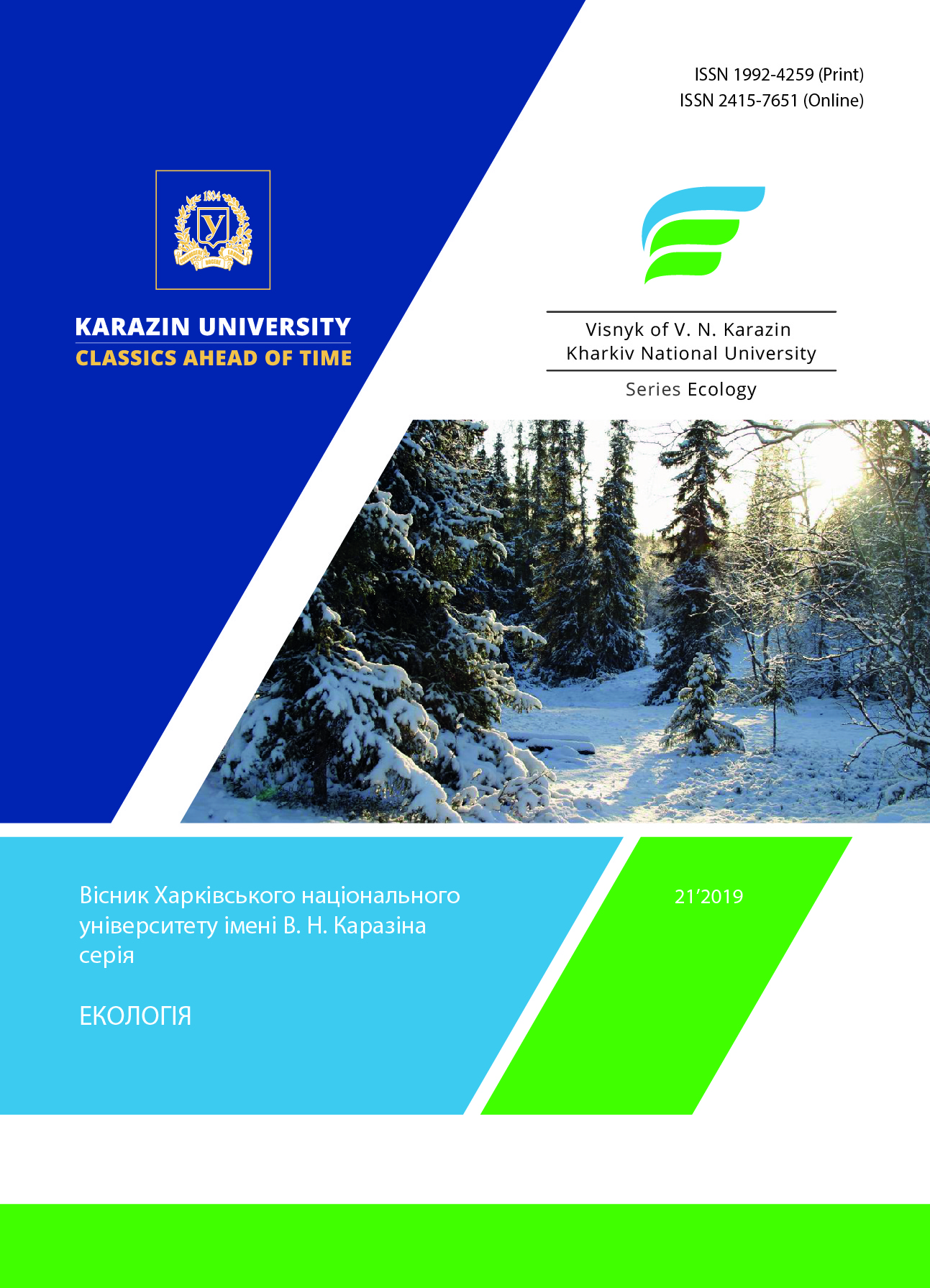Вивчення залежності токсичного ефекту від часу контакту токсикантів з культурою водорості
Ключові слова:
біотестування, водорості, чутливість, токсиканти, токсичний ефектАнотація
Актуальність. Інтенсивність фотосинтезу є найпоширенішим тестом на токсичність при використанні водоростей в якості тест-об'єктів. Всі методи визначення фотосинтезу засновані на вимірі швидкості виділення кисню або поглинання вуглекислого газу в середовищі інкубації до і після певної експозиції культури водоростей на світлі. Мета. Визначення порогових для даного методу концентрацій токсичних речовин і вивчення залежності типу доза-величина токсичного ефекту. Методи. Біотестування за допомогою мікроводоростей. Результати. Біотестування токсичності методом оцінки фотосинтетичної активності водоростей можливо тільки для стічних вод, що володіють гострою токсичністю. Пряма залежність між величиною токсичного ефекту і тривалістю контакту водоростей з токсикантами спостерігається приблизно протягом години. Подальше збільшення часу контакту майже не підвищує токсичний ефект. Висновки. Збільшуючи час контакту водоростей з токсикантами, можна значною мірою підвищити чутливість методу і, можливо, використовувати його для оцінки слаботоксичних стічних вод. Однак, для остаточних висновків про межі чутливості методу, а, отже, і про область його застосування необхідні додаткові дослідження.
Посилання
Филенко О. Ф. Водная токсикология. Черноголовка: ОИХФ АН СССР, 1988. 155.
Патин С. А. Эколого-токсикологические аспекты изучения и контроля качества водной среды. Гидро-биол. журн. 1991. Т. 2. Вып. 6. С. 71-75.
Патин С. А. Эколого-токсикологические подходы к оценке воздействия на морскую среду и биоресур-сы. Актуальные проблемы водной токсикологии./под ред. Б. А. Флерова. Борок: Рыбинский дом пе-чати, 2004. С. 34-60.
Крайнюков А. Н., Крайнюкова А. Н., Чистякова Е. О. Мониторинг возвратных вод химического пред-приятия и качества воды в контрольных створах водного объекта. Проблеми охорони навколишнього природного середовища та екологічної безпеки. Харків, 2012. Вип. 35. С. 51-60.
Крайнюков О. М. Біоекологічні методи дослідження аквальних ландшафтів. Фізична географія та геоморфологія. 2013. Вип. 3 (71). С. 158-167.
Крайнюков О. М., Кривицька І. А Встановлення нормативів екологічної безпеки рибогосподарського водокористування на основі ландшафтно-екологічного підходу (на прикладі морфоліну). Молодий вчений. 2016. №12. С. 15-18.
Nikookar K., Moradshahi A., Hosseini L. (2005) Physiological responses of Dunaliella salina and Dunaliella tertiolecta to copper toxicity. Biomol. Eng. 22. P. 141–146. https://doi.org/10.1016/j.bioeng.2005.07.001
Beneche G. Automatisierung der auswertur einer algenheteste hemmung der kreichenbewegung einer blaualge (Phornidium sp.) durch deigat. Z. Waasser und Abwasser-Forsch. 1977, №6. P. 195-197.
Raso J., Rachlin I. The effect of cadmium, copper, mercuru, zincum and lead on cell division growth and chlorophyll a content a content of the chlorophyte Chl. vulgaris. Bull. Torreu. Bot. Club. 1977. №3. P. 226-233.
Garcíaríos V, Freilepelegrín Y, Robledo D, Mendoza-cózatl D, Moreno-sánchez R, Gold-bouchot G. (2007) Cell wall composition affects Cd2+ accumulation and intracellular thiol peptides in marine red algae. Aquatic Toxicol. Vol 81. P:65–72. https://doi.org/10.1016/j.aquatox.2006.11.001
Брагинский Л. П. Некоторые итоги исследований по водной токсикологии в Украине. Актуальные проблемы водной токсикологии. /под ред. Б. А. Флерова. Борок: Рыбинский дом печати, 2004. С. 11-33.
Cullimore, D. R. A qualitative method of assessing the available nitrogen, potassium and phosphorus in the soil. J. Sci. Food Agric., 1996,Vol. 17. P. 321-323. doi:10.1002/jsfa.2740170709.
Radix P, Leonard M, Papantoniou C et al. Comparison of four chronic toxicity tests using algae, bacteria, and invertebrates assessed with sixteen chemicals. Ecotoxicol Environ Saf . 2000. Vol.47. P.186–194.
María Elena Sáenz, Walter Darío Di Marzio and Jose Luis Alberdi, (2012) Assessment of Cyfluthrin commercial formulation on growth, photosynthesis and catalase activity of green algae, Pesticide Biochemistry and Physiology, 2012., Vol. 104, No1. P. 50-57. https://doi.org/10.1016/j.pestbp.2012.07.001
Heijerick D. G., Bossuyt B. T. A., De Schamphelaere K. A. C., Indeherberg M., Mingazzini M. and Janssen C.R., (2005) Effect of Varying Physicochemistry of European Surface Waters on the Copper Toxicity to the Green Alga Pseudokirchneriella subcapitata, Ecotoxicology. 2005. Vol. 14. No 6. P. 661-670. https://doi.org/10.1007/s10646-005-0014-8
##submission.downloads##
Опубліковано
Номер
Розділ
Ліцензія
Автори, які публікуються у цьому журналі, погоджуються з наступними умовами:
- Автори залишають за собою право на авторство своєї роботи та передають журналу право першої публікації цієї роботи на умовах ліцензії Creative Commons Attribution License 4.0 International (CC BY 4.0), котра дозволяє іншим особам вільно розповсюджувати опубліковану роботу з обов'язковим посиланням на авторів оригінальної роботи та першу публікацію роботи у цьому журналі.
- Автори мають право укладати самостійні додаткові угоди щодо неексклюзивного розповсюдження роботи у тому вигляді, в якому вона була опублікована цим журналом (наприклад, розміщувати роботу в електронному сховищі установи або публікувати у складі монографії), за умови збереження посилання на першу публікацію роботи у цьому журналі.
- Політика журналу дозволяє і заохочує розміщення авторами в мережі Інтернет (наприклад, у сховищах установ або на особистих веб-сайтах) рукопису роботи, як до подання цього рукопису до редакції, так і під час його редакційного опрацювання, оскільки це сприяє виникненню продуктивної наукової дискусії та позитивно позначається на оперативності та динаміці цитування опублікованої роботи (див. The Effect of Open Access).

